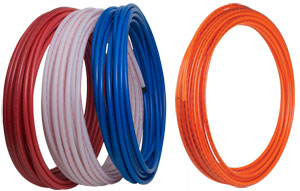In this presentation, Gary Klein shares important information about air source heat pump water heaters (HPWH), with particular attention paid to where the warm air comes ...
How Many Times Can PEX Freeze Before Bursting?

A member of The Wall community asked this question and I thought the conversation that followed was interesting:
"How many times can PEX freeze before bursting? At what temp will it only take once? Will it just expand and contract forever without damaged? Does it get significantly weaker? I'm not asking about PEX in a slab, but under a floor for example. Or would a cooper shower riser split before the PEX, or would the PEX expand enough to protect it? I've seen PEX-Aluminum-PEX pipe in a floor freeze, and badly. I've seen the results from a "test" under the floor(my nephew did that one). But what do you think?"
And this is what a member had to say:
"We had some 1" PEX run in an attic that, due to several weird circumstances, froze up solid - like about 70 feet in length. It was stiff as a board. My man went up there with a heat gun, and after about two hours of thawing, we got it flowing again. The whole 70 feet was solid and did not break or split. Copper would have failed, without a doubt. I have a hunch that regular PEX would be even more resistant to freeze damage than the PEX-Aluminum-PEX products because PEX is just more flexible. About the only things I've found that will damage PEX is a nail or too much sun. It is tough beyond belief."
And from another member:
"We had a PEX-Aluminum-PEX failure this winter. It seems the contractor left an opening to the wind and weather in a chase that we used to run the PEX. The wind-chill was -15°F on this day. The pipe froze hard, and the wind was hitting right on a tee. My theory about the leak is that the PEX expanded lengthwise, as it is prone to do, but it also expanded the press fitting in the same spot where the freeze took place. Then, when the thawing occurred, the fit was weakened and the pressure of the water main pushed against the freeze plug ahead of it, causing the pipe to pull away from the fitting. We could see that the press RING was pushed away from the press position while freezing , and during the thaw, it separated from the fitting due to pressure/displacement during the thaw cycle.We have high pressure in most homes here, until we install a pressure-reducing valve on the main. I believe the PEX-Aluminum-PEX product thawed BEFORE the freeze on the rest of the system did, and the PEX came off of the fitting. I hope this makes sense. I can't think of any other way to explain it. We had the press tool tested, and found to be within tolerances accepted as proper."
And another:
"I used to do a lot of pex in Alaska. There was a three-bedroom house I had just finished. The homeowner left for Hawaii for two weeks. The heat went out and the place was frozen solid at -40 F for two weeks. He called me when he got back. I went over, changed the manifold and got him going. Not one pipe was broken. I was in and out in less than 45 minutes. I was convinced that if there was some sort of pressure relief valve on the manifold, even it wouldn't have broken."
And this:
"I'm currently living in a nice home, which I don't own, in a ski-resort town. There is a utility room off of the garage, but no water would flow from the sink last weekend. I opened the faucet a little and, late in the afternoon, it thawed and water flowed. Both cold- and hot sides froze. This house is eight years old. It has PEX tubing throughout. The owner says he has never noticed the pipes to this sink freezing before (he is here most of the winter). Strangely, the sink doesn't get used much. I believe the conditions have been relatively constant over the years. It has frozen for the past three nights, but if I open the faucet, it thaws in the afternoon (I have also been playing with the garage thermostat). Potentially, this tubing has seen hundreds of freeze/thaw cycles! It's possible it has stayed frozen for most of the winter, but it certainly has seen freeze/thaw cycles during spring and fall. So I'm guessing it has seen at least 100 cycles and likely many more. I am a materials engineer and this amazes me! But I think we had better fix the problem because eventually that tubing will break. In the short term I will let the faucet drip."
Jay Burch added this:
A study at NREL was done on freezing of PEX piping in 2005. Two PEX piping brands in various lengths and orientations were freeze-thaw cycled over 500 times without damage. Tensile data were taken at 0 C, indicating that the expected extension under uniform freezing was just within the linear portion of the stress-strain curve, indicating no permanent wall thinning at freeze. Testing included the fittings placed between one-inch to seven-inch pieces; a few brass fittings did break, but none of the plastic fittings available broke. A few of the 7" pieces broke. A PEX pipe with insulation tapered from zero to maximum in the center broke (as expected). Hypotheses are provided for why there was breakage in these somewhat anomalous situations (all to be avoided). PEX-AL-PEX was no better than copper, which can be frozen a few times without bursting. Details are available in a conference paper published at ASES in 2006: "Northward Market Extension for Passive Solar Water Heaters by Using Pipe Freeze Protection with Freeze-tolerant Piping", where results for PEX tests are presented (and see references therein).
Leave a comment
Related Posts

In this all-technical three-hour seminar, Dan Holohan will give you a Liberal Arts education in those Classic Hydronics systems. He’ll have you seeing inside the pipes as...
We always have turkey for Thanksgiving. I mean who doesn’t? My job wasn’t to cook it, though; it was to eat it.